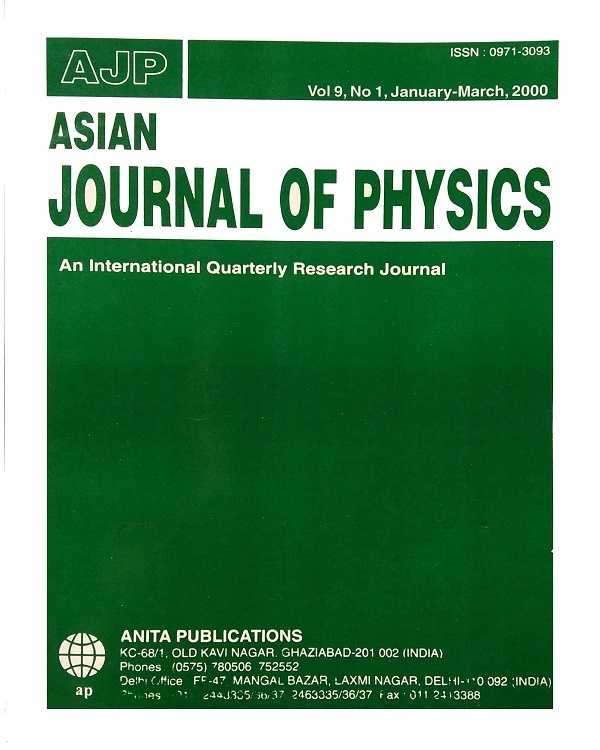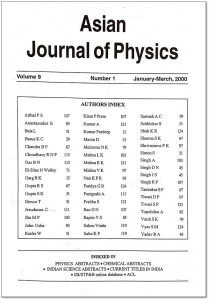Editor-in-Chief : V.K. Rastogi

ASIAN JOURNAL OF PHYSICS
An International Peer Reviewed Research Journal
Frequency : Monthly,
ISSN : 0971 – 3093
Editor-In-Chief (Hon.) :
Dr. V.K. Rastogi
e-mail:[email protected]
[email protected]
| AJP | ISSN : 0971 – 3093 Vol 9, No. 1, January-March, 2000 |
Asian
Journal of Physics
Vol 9, No. 1, January-March, 2000

CONTENTS
|
Simple variational principle I : Theory and application to
thermoelectric phenomena |
|
|
Christopher G Jesudason |
1 |
|
Photothermal spectroscopy and its application in characterisation of
polycyclic aromatic hydrocarbons |
|
|
R K Garg and Pardeep Kumar |
15 |
|
Techniques and applications of electron paramagnetic resonance
spectroscopy
|
|
|
S K Gupta |
31 |
|
Force field for planar modes of fluorobenzene revisited
|
|
|
J S Singh, D N Singh and R A Yadav |
45 |
|
Spectroscopic studies of iron doped B203-Bi203 glasses
|
|
|
L Baia, D Maniu, T Iliescu,S Simon, S Schlücker and W Kiefer |
51 |
|
I-V and C-V measurements on Al203 based MOS structures. |
|
|
A C Sarmah and K C Barua |
59 |
|
Mechano and electroluminescence spectroscopy of Cu and Mn doped ZnS
phosphors
|
|
|
R S Gupta, S P.Tamrakar, S K Sharma and B P Chandra |
67 |
|
An approach for efficiency determination of HPGe detectors used in
γ-ray spectroscopy techniques
|
|
|
N Walley El-Dine |
71 |
|
Structural studies of some polar molecular systems using microwave
absorption technique and nuclear magnetic resonance
|
|
|
S K Vaish and N K Mehrotra |
79 |
|
Lattice dynamics of tellurium subchloride- A Raman study
|
|
|
Y S Raptis, E Anastassakis and A Topalidou |
85 |
|
Ionic character and dipole moments of alkali halides from their
electronegativity data
|
|
|
K P R Nair and Usha John |
93 |
|
Correlative study of interplanetary plasma parameters during the period
of 1978-83
|
|
|
V K Mishra, D P Tiwari and Pankaj K Shrivastava |
97 |
|
An evaluation of temperature dependent electrical resistivity ρ(T) and
thermoelectric power S(T) for TiS2, Cox,TiS2 and NixTiS2
|
|
|
M P Jha, A Singh and L K Mishra. |
103 |
|
Optical limiting and nonlinear absorption studies in Bi12SiO20 crystal
at high power nanosecond laser regime |
|
|
P Sreeramana Aithal, R P Singh, P Prem Kiran and D Narayana Rao |
107 |
|
Structural and dielectric properties of Sr5RTi3Nb7O30 [R = Nd, Eu, Gd
and Dy] ceramics |
|
|
A Panigrahi, R N P Choudhary and B N Das |
115 |
|
Quantum mechanical study of CP violation
|
|
|
Vinita Sahoo and K P Sahu |
119 |
|
Conversion electron lines of a new gamma transition of 1.51 MeV in the
decay of 207Bi
|
|
|
R K Mishra, A Kumar, Shashi Prabha and S P Tiwari |
121 |
|
Growth features and dislocation etching of In Bi0.8Se0.2
|
|
|
G R Pandya, K R Shah and S M Vyas |
124 |
Articles
Vol. 9, No 1 (2000) 45-50
Force field for planar
modes of flurobenzene revisited
J S Singh,D N Singh and R A Yadav*
Department of Physics, Laser and Spectroscopy Lab, Banaras Hindu University,
Varanasi-221 005, (India)
The force field calculations for planar modes of
flurobenzene have been revisited using more accurately observed values of
fundamentals [J Mol Spectrosc, 73 (1978)290] of parent molecule and its two
deuterated analogues namely, flurobenzene –p-d and –d5. A 38
parameters force field has been determined leading to alteration of the earlier
vibrational assignments for some of the normal modes. The doblet observed at
2274.4 and 2304.4cm-1 as A type IR bands for p-d fluorobenzene could
be explained as arising due to the Fermi resonance between the (C-D) fundamental
and the first overtone of the CHplanar bending mode observed at 1156 cm-1.
Three force constants for the stretching of the c-c bonds of the ring have been
taken in view of the C2v symmetry and similarly, 3 force constants for the CH
stetchings and the bendings and 4 force constants for the planar ring bendings
have been taken . It is found that the force constants involving different C-C
bond stetchings vary within 2%, those involving CH strechings and bendings vary
within 1% and 7.5% respectively . However, the force constants involving the
ring bendings show rather a large variation of 28%.
Total Refs : 10
Vol 9, No 1 (2000) 51-57
Spectroscopic studies of iron doped B203-Bi203
glasses
L BAIA, D MANIU, T ILIESCU and S SIMON*
Babes—Bolyai University, Physics Department, 3400,
Cluj—Napoca, Romania
And
S SCHLUCKER and W KIEFER*
Institut fur Physikalische Chemie, Universitat Wurzburg,
Am Hubland, D-97074 Wiirzburg, Germany
Raman and IR spectra of 99.5%[xB203(1—x)Bi203]0.5%Fe203 glasses
with different Bi/B nominal ratios (0.20 ≤ x ≤ 0.80) have been investigated. The
influence of bismuth atoms on the vitreous B203 network as
well as the local order changes both around bismuth and boron atoms are studied.
The very low content of Fe203 introduced in these samples
has no structural effect on the bismuth-borate glass matrices as far as
evidenced by the methods used.
Total Refs : 27
Vol. 9, No 1 (2000) 107-114
Optical limiting and nonlinear absorption
studies in Bi12SiO20 crystal at high power nanosecond
laser regime
P Sreeramana Aithal, R P Singh, P Prem Kiran and D
Narayana Rao
Nonlinear absorption properties of Bi12SiO20 (BSO
) crystal are studied using single beam Z-scan technique in the nanosecond
regime without applying external electric field. We observed a strong nonlinear
absorption at 532 nm (SHG of an Nd: YAG laser) and at 595nm (Nd:YAG pumped dye
laser) . We have also studied the optical limiting and the laser damage
threshold of the crystal at both the wavelengths. A physical model is developed
to explain the observed behavior using photorefractive properties of BSO crystal
which incorporates the accumulative trap assisted excited state absorption and
the instantaneous two-photon absorption which makes it as an excellent optical
limiter.
References: 15
